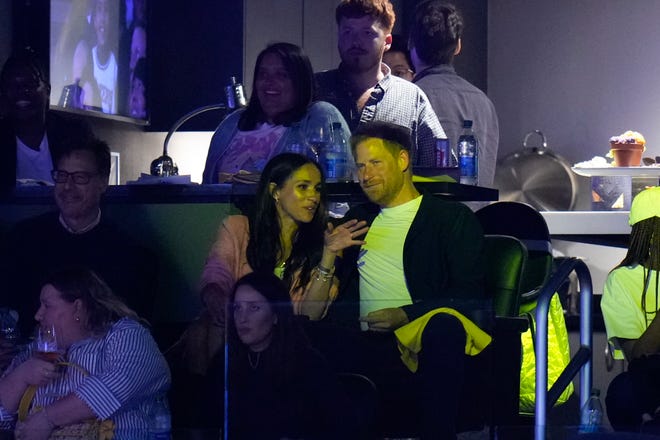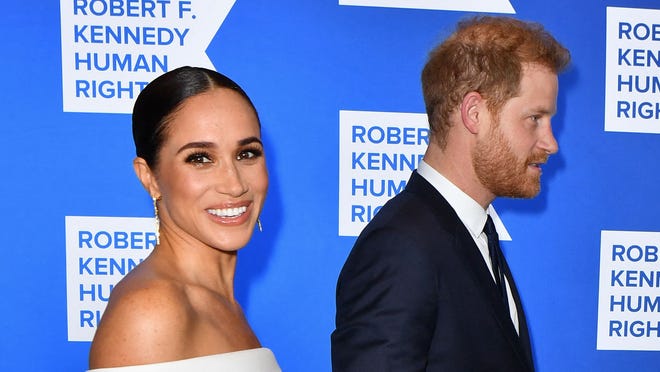Security experts challenge details of Harry and Meghan's 'chaotic' chase with paparazzi
While there may be some debate on whether Prince Harry and his wife Meghan were involved in a "near catastrophic" car chase with paparazzi in New York City Tuesday night, two renowned private security experts who work with famous people believe they might not have taken the proper precautions.
"They likely did not have any formal protective training to deal with this type of situation," said Kent Moyer, president and CEO of the L.A.-based World Protection Group. "Did they do any prior route planning? Did someone do any sort of surveillance? And what was the plan to get out of a potential problem and did their security have any evasive driving training?"
Jerry Heying, the president and CEO of the New York-based International Protection Group agrees and asks, "Did they have enough personnel within their detail?"
Despite social media and smartphones allowing celebrities, dignitaries and other notable figures more direct interaction with fans directly, the public's lust for paparazzi shots is still voracious, begging the question: Are paparazzi a danger in the U.S.?
No, Moyer and Jerry Heying, say. But celebs and popular people need to have better coordination when appearing in public and dealing with those photographers who are paid to shoot nearly every move they make.
The experts say most celebrities use what they call "executive dignitary protection" – a security detail that can go to great lengths at times to ensure safety and is comparable to the Secret Service. Such a detail involves extensive planning.
"We call that 'advance work,'" said Heying, whose companies have helped support the Secret Service's protection of former Presidents George H. W. Bush, Bill Clinton and Barack Obama. "We can get notice from a client sometimes months, weeks, days – sometimes hours in advance. Depending on who they are, we coordinate with that city's local police precinct if necessary and reach out to the venue where they are supposed to be and likely ask 'What door are we going to come in, coming out of, and how close can our detail get to the entrances and exits?'
"We try to minimize any potential risks as much as possible," Heying added.
Harry, Meghan claim car chase with papsPrince Harry, Duchess Meghan say they were in 'near catastrophic' car chase with paparazzi
Duke and Duchess reps said the couple were in 'near collisions'
The official office of the Duke and Duchess of Sussex said the couple and Meghan’s mother, Doria Ragland, were followed for more than two hours by half a dozen vehicles Tuesday after leaving a charity event. The three were in New York City for the Ms. Foundation for Women's annual gala where Meghan accepted the Ms. Foundation Women of Vision Award.
In a statement to USA TODAY Wednesday, the couple's office said that the paparazzi's chase to capture photos of Harry and Meghan "resulted in multiple near collisions involving other drivers on the road, pedestrians and two NYPD officers."
The statement called the incident "near catastrophic."
"While being a public figure comes with a level of interest from the public, it should never come at the cost of anyone’s safety," the statement said. "Dissemination of these images, given the ways in which they were obtained, encourages a highly intrusive practice that is dangerous to all in involved.”
New York City police spokesman Julian Phillips told USA TODAY in an emailed statement that the NYPD assisted in protecting the duke and duchess along with their private security team.
"There were numerous photographers that made their transport challenging," he said. "The Duke and Duchess of Sussex arrived at their destination and there were no reported collisions, summonses, injuries, or arrests in regard."

But Heying questions how long the chase was and how much official protection Harry and Meghan had.
"If NYPD was attached to them, this 'chase' could not have happened for this long, it's just not possible," Heying said. "A more professional security person would know not to cause potential harm and if they were being chased, you go to a safe place, a firehouse, a police station in particular.
"You would pull in there and say 'These people are chasing us' and the police would stop and question them and the paparazzi would likely drive away."
Moyer said if Harry and Meghan had a security detail of two or more cars, they would've tried strategies including having one or more vehicles in the rear driving slower to try and hit red lights and stall the paparazzi's relentless pursuit, while the lead "principal car" drives ahead and can possibly take alternate routes.
The rest of the detail would eventually catch up with the lead car, Moyer said. "The team should be able to detect in seconds if it's the paparazzi or a really a threat to their safety."
Celebs say paparazzi not going anywhereLil Nas X, Jennifer Lopez, Grimes and the enduring appeal of celebrity paparazzi photos
New York's Mayor even wonders if Harry and Meghan were in an actual chase
New York City Mayor Eric Adams expressed doubt that the car chase lasted two hours and said city officials will find out the exact duration.
"I would find it hard to believe that there was a high-speed, two-hour car chase," Adams said Wednesday. "But if it's a 10-minute chase, it's extremely dangerous in New York City. We have a lot of traffic, a lot of movement, a lot of people are using our streets. Any type of high-speed chase that involves something of that nature is inappropriate."
Chris Sanchez, a member of the Duke and Duchess' security detail, told CNN Wednesday they were dealing with about a dozen vehicles including cars, scooters and a bicycle during the "chaotic" chase.
"The public were in jeopardy at several points. It could have been fatal," Sanchez told the network. "They were jumping curbs and red lights. At one point, they blocked the limousine (carrying the couple) and started taking pictures until we were able to get out."
While there are no anti-paparazzi laws in New York, California has one that prohibits paparazzi from trespassing on private property, using telephoto lenses to survey private property, or pursuing targets in cars.
ScarJo chastises paparazzi for chaseScarlett Johansson slams paparazzi for chase: 'Just a waiting game' until someone gets killed
Experts say they still use Princess Diana's tragic death in their training
Both Heying and Moyer say they still use the 1997 death of Harry's mother, Princess Diana, as an example in their security training. She was killed in a car crash in Paris in 1997 while trying to avoid the paparazzi.
"As unfortunate as that tragedy was, we still use that as a case study of what not to do, where’s the threat?" Heying said. "My company’s policy when dealing with paparazzi is to go slow and diligently and make sure you don’t endanger the client or anybody else.'
"Were Harry and Meghan frightened? Probably so. Remember, 'paparazzi' is an Italian word for pest," Heying said. "They're bothersome, but you don't want to cause harm all for some photos."
Given the safety risks, Heying said that's why he was surprised that Harry would apparently go to such lengths to avoid the paparazzi. Heying recalled when paparazzi hit and forced Arnold Schwarzenegger and his then-pregnant wife, Maria Shriver, and their young son off the road in 1997.
When he became California's governor, Schwarzenegger signed California's anti-paparazzi bill into law.
"It's just not worth your life," Heying said.
What does this incident say about society?
Vanessa Díaz, a professor and author of the book "Manufacturing Celebrity: Latino Paparazzi and Women Reporters in Hollywood," encourages people to use this incident as a way to examine celebrity culture at large, rather than demonize paparazzi, many of whom, she says, come from disenfranchised backgrounds and do this work out of necessity.
"It's a really easy scapegoat to kick the people who are already at the bottom of the entertainment system, who are already disparaged instead of actually dealing with the power structures that demand the labor," she says. "We have to think a lot more critically about how these situations are framed and what bigger kind of power dynamics are really at play here."
Instead of placing the blame entirely on paparazzi, Díaz says broader issues like our culture’s obsession with celebrities and the financial incentives in society for glimpses at their personal lives also contributed.
Contributing: Charles Trepany, USA TODAY

No comments: